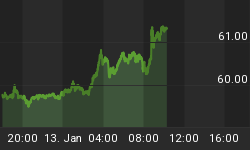In October of last year, we published a platinum-market overview in the Casey International Speculator and concluded by saying: "We recommend avoiding South Africa, and in this context it means staying away from platinum producers located there. If the energy situation spins out of control, miners' strikes continue, and the local trouble puts an indefinite halt to a significant portion of platinum production, some speculative opportunities may appear in the physical-metal market or platinum-backed investment tools. If we see signs of that happening, we may speculate on the results."
Although some of the events that we expected did occur this year, the "indefinite halt" has not. The nationwide wildcat strikes that ended in mid-November suggested that that scenario was possible, but the bubbling pot simmered down. We were asked by our readers to share our view on the implications of those actions on the price of platinum.
So, what is the outlook for the platinum market now, and is it time to buy?
State of the Market
Let's start with some context. According to Johnson Matthey's Platinum 2012 report, the platinum market in 2011 was in a state of surplus. Primary supply rose by 7% to a four-year high of 6.5 million ounces, while total demand grew only 2%. All segments of the platinum market expanded except investment demand, which declined 30% year-on-year.
Supply from South Africa grew by 5% in 2011, but not from actual mining. It was "due to releases of metal from in-process and refined inventories." Mine production fell by 3% because of safety stoppages and labor disruptions.
Production in South Africa was unstable throughout 2011, and Johnson Matthey forecasted that difficulties would continue in 2012, with an anticipated decrease in total supply. Well, the analysts were right: through mid-September, BMO Capital Markets estimated that 250,000 fewer ounces were produced, due to the labor disputes we've seen so much about in the news. The overall impact of the South African labor strikes on the supply-demand balance, as estimated by Johnson Matthey in its Platinum 2012 Interim Review, will amount to "at least 300,000 oz." The report predicts that the platinum market will end this year in a state of deficit, by about 400,000 ounces. Demand is projected to remain steady at about 8.1 million ounces, whereas global supply will decline.
On the surface, this might sound like a buying opportunity; but before we jump in, let's take a look at the full demand picture.
Industrial Demand
Johnson Matthey expects industrial demand to fall by 13% in 2012. BMO estimates that slow European auto sales have translated into a loss of 280,000 ounces of platinum demand through mid-September. This by itself almost offsets the forecasted 300,000-ounce drop in production caused by labor strife.
The net impact on the supply-demand relationship is, again, mixed: demand is expected to remain relatively stable. This year's supply disturbances may not necessarily cause a major, long-term imbalance due to the influence of the third part of the equation: recycling. In fact, the report explicitly states that recycling, not the South African supply issues, "will be a key factor in the platinum market balance in 2013."
Downside Risk Remains
If you accept the Casey view that global economic hardship is far from over, the downside risk for platinum is significant. Platinum and other platinum group metals (PGMs) are industrial commodities, and trends in their industrial demand can serve as a good indicator of price movements. So far, we have not seen signs of significant improvement in the global economy. We here at Casey Research do not believe that further monetary-easing efforts will cure what ails the US and global economies, so our bearish outlook for the industrial metals, including PGMs, stands.
This doesn't, however, mean that we won't see interim spikes in the platinum price, such as the recent one that followed the deaths of 47 protesting miners in South Africa. Fear gripped the market, and a short-term rally ensued. Was that reaction justified? Yes, given how much platinum production comes from South Africa and how bad the situation there is.
That behavior, though, is driven by panic, not fundamentals, and was short lived. It is very different from what we see in the gold market, where fundamentals do support long-term bullishness for an asset that serves as both money and a hedge against economic uncertainty, despite short-term, knee-jerk reactions.
In other words, until signs of global economic growth emerge or we see serious, permanent supply destruction, we view any movements in the platinum market as fleeting, not fundamental.
What Does It Mean?
Now that the large, nationwide strikes have ended, investors are trying to assess their impact on the supply-demand balance. After all, they were a primary factor driving perception of the platinum market this year. However, we doubt that the recent strikes will have a deep and lasting impact on the state of the platinum industry. Whatever lingering effects there might be will not be more powerful than the ongoing global economic weakness.
Although the platinum market is now estimated to end the year in deficit, unless there's a new and even greater supply disruption, the existing recycling output will likely adapt and fill in the 2012 supply gap rather quickly, especially if prices move up.
Investors who are more bullish on the economy than us might want to speculate on platinum now, to benefit from a pop in prices should the estimates of the global market deficit become reality. As for us, we plan to stick with our preferred monetary metals: gold and silver.
Holding physical metals is a great way to protect your wealth against inflation, which is widely regarded to be baked in the US economic cake already. To increase your wealth, however, investing in the right precious-metal companies is the way to go - and now is precisely the right time to get in, as prices are incredibly low on some sound companies. Get the details here.















